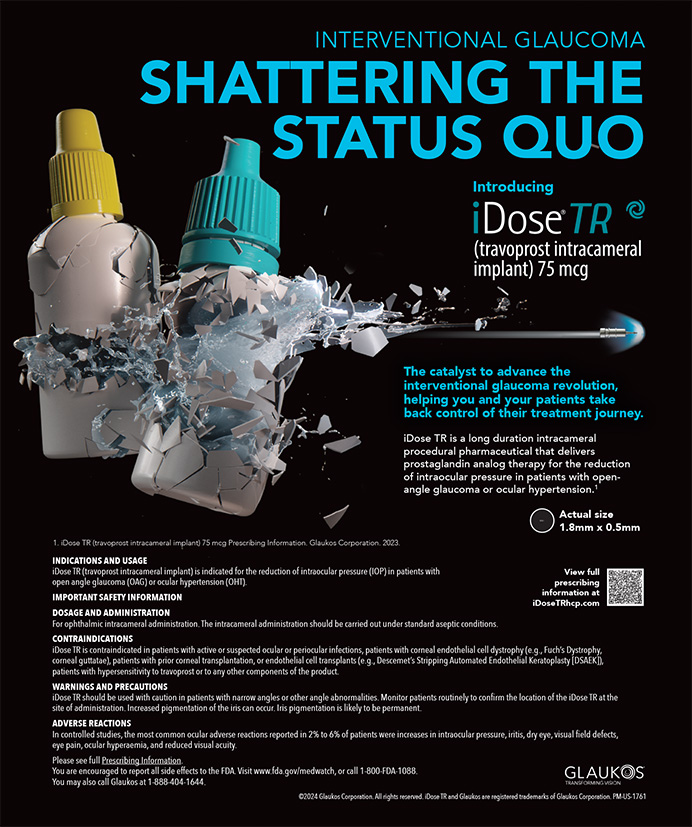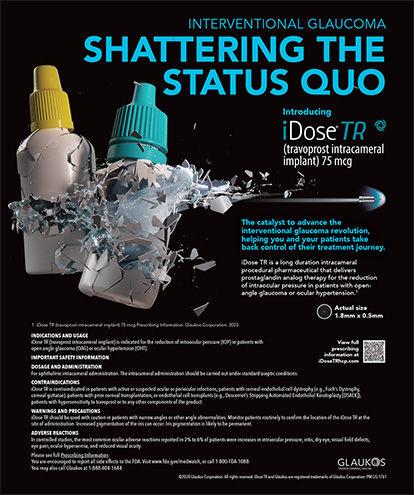class="red">CASE PRESENTATION
A 29-year-old male presented for evaluation. His past medical and ocular history were negative. On examination, his BSCVA was 20/25 OU with a refraction of -15.75 D OD and -15.50 D OS. The slit-lamp examination and dilated fundus examination were normal. The anterior chamber depth was 3.9 mm in both eyes. The endothelial cell density was 2,674 cells/mm2 and 2,599 cells/mm2 in his right and left eyes, respectively. The horizontal white-to-white measured 12.5 mm in both eyes.
After a discussion, the patient was scheduled to receive the Visian ICL (V4; STAAR Surgical Company, Monrovia, CA) in his right eye. The surgeon created a laser peripheral iridotomy (PI) in the eye 1 week before implanting the lens. The procedure was uneventful. On the first postoperative day, the patient's UCVA was 20/25, and the IOP measured 14 mm Hg. The anterior chamber was deep, and the ICL was well positioned. Three days postoperatively, the patient returned complaining of blurred vision and pain. On examination, his UCVA was 20/80, the cornea exhibited microcystic edema, the peripheral anterior chamber was flat, and the ICL appeared to be vaulted anteriorly. The PI seemed to be patent. The IOP was 49 mm Hg.
What is your differential diagnosis, and how would you manage this case?
BRIAN S. BOXER WACHLER, MD
The differential diagnosis includes pupillary block from a phakic PCIOL, malignant glaucoma, retained viscoelastic, and a suprachoroidal hemorrhage. Bylsma et al described a very similar case. More importantly, in their article, the authors provided an extremely important algorithm for diagnosing the cause of high IOP after the implantation of the Visian ICL or another phakic PCIOL as well as options for its treatment (see specifically Figure 6 from their article).1 With this article in mind, I would note that this case report omits two important pieces of information regarding etiology: (1) the amount of vaulting between the ICL and the crystalline lens and (2) whether the crystalline lens is in the normal position or has shifted anteriorly. Bylsma et al described the typical absence of the iris bombe configuration with pupillary block from a phakic PCIOL because of the implant's presence posterior to the iris.1
Malignant glaucoma could have resulted from aqueous misdirection into the vitreous. If so, the crystalline lens would have shifted anteriorly as well. A suprachoroidal hemorrhage is also possible and would be revealed by a fundus examination. I have never seen a case of malignant glaucoma or suprachoroidal hemorrhage after the Visian ICL's implantation. Retained viscoelastic would have cleared by postoperative day 3, so it is not likely the cause of the high IOP in this case.
The probable diagnosis in this case is pupillary block from a phakic PCIOL. This condition is the most common cause of high IOP several days after the Visian ICL's implantation. Pupillary block results from nonfunctioning PIs. Confirmed transillumination of the PIs is not a reliable sign of their patency. The only way to verify patency is to visualize the structures posterior to the PI's opening, like the edge of the ICL or anterior capsule. Based on data for the ICL's FDA premarket approval, most surgeons perform Nd:YAG PIs, and approximately 5% of them do not function, which leads to increased postoperative IOP. Dilating the iris can often temporarily break the pupillary block.
The definitive treatment is to enlarge the PI(s) and/or create additional PIs, either surgically or with the Nd:YAG laser. An oversized ICL (excessive vault) increases the risk of pupillary block in eyes with nonfunctioning PIs, and such eyes generally will not respond to dilation to break the block. I have observed several cases of excessive vaulting, but as long as the PIs were patent, the IOP remained normal. In this case, if the lens has high vaulting and the patency of the PIs is confirmed, then exchanging the ICL for a shorter model should resolve the excessive vaulting and lead to normalization of the IOP.
RANDY J. EPSTEIN, MD, AND STEVEN V. L. BROWN, MD
The findings in this case include a flat peripheral anterior chamber. No information is given regarding the central anterior chamber depth or the appearance of the pupil. In their informative article, Bylsma and associates stressed the importance of determining if "shallowing" is due to changes in the anterior or the posterior chamber or both (combined chamber depth).1 If the combined chamber depth is indeed what is shallow here, the most likely diagnosis is aqueous misdirection or malignant glaucoma. This problem is best treated aggressively with strong topical cycloplegics (eg, atropine) to relax the ciliary muscle and increase the ciliary ring's diameter as well as oral and topical IOP-lowering agents. Barring medical contraindications, the patient should receive 10% phenylephrine eye drops. The definitive treatment of aqueous misdirection is an Nd:YAG laser application to the anterior hyaloid face (although this procedure is not easily performed in the presence of corneal edema) through the PI or surgical aspiration of the aqueous
"pocket" from the vitreous. Surgeons should never use miotics in these cases, because these drugs cause ciliary body congestion. Oral hyperosmotics and topical steroids, in addition to the other measures described, can yield up to a 50% success rate with medical treatment alone in this situation.2 The surgeon should perform a careful fundus examination and/or B-scan (if the fundus cannot be adequately visualized) to rule out a choroidal hemorrhage/detachment.
If the combined chamber depth is normal but the anterior chamber is shallow (unclear from the case presentation) and the ICL's vault is high, then presumptive pupillary block is the most likely diagnosis. Bylsma et al noted that pupillary block occurs in up to 4.3% of patients with two (presumably patent) PIs. The problem resolved after the enlargement of the existing PIs or the placement of additional PIs.1 Because this eye received only one PI, creating a second will probably resolve the problem. Pupillary block is not likely unless the peripheral iris is bowing forward, and this complication usually presents within 48 hours of surgery. It can resolve temporarily after pupillary dilation.
If adding another PI does not alleviate the problem, and gonioscopy shows a closed angle, then the ICL may be too large, causing excessive vaulting. In that case, the PCIOL must be exchanged or removed, as described by Chan et al.3 Pupillary dilation can help to make this diagnosis, as it will not relieve excessive vaulting. Because the implanted lens is a V4, it is unlikely that vaulting per se is the problem. Most surgeons use the ICL size recommended by the manufacturer, which is based primarily on white-to-white measurements (in our experience, most reliably obtained from the IOLMaster [Carl Zeiss Meditec, Inc., Dublin, CA]). STAAR Surgical Company still recommends performing two PIs 90° apart. It is not always possible to prevent the ICL's haptic from occluding a single PI, even if it is patent, which leads to pupillary block. Testing with optical coherence tomography (Artemis 2; Ultralink LLC, St. Petersburg, FL), if available, could help to define the anatomical issues, as discussed by Chan et al.3
EZRA MAGUEN, MD
The differential diagnosis in this case is pupillary block with or without preexisting plateau iris or aqueous misdirection (ciliary block glaucoma). Initial management will be geared toward relieving the pupillary block, if present, with maximum topical medications, oral Diamox (Wyeth Pharmaceuticals, Philadelphia, PA), and a second laser PI away from the lens implant.
If there is no improvement, the surgeon must manage the aqueous misdirection. The patient should undergo a pars plana vitrectomy as soon as possible to relieve pressure and create space in the anterior chamber. The lens implant should then be removed. Aqueous misdirection has been described in phakic and pseudophakic eyes but not in eyes with phakic lens implants.4 I have managed two such cases.
AUDREY R. TALLEY-ROSTOV, MD
The differential diagnosis includes malignant glaucoma (aqueous misdirection) and pupillary block from a phakic IOL.1,2 Initial management should include pupillary dilation with topical cyclopentolate and phenylephrine 2.5%, topical timolol 0.5%, topical brimonidine, and intravenous acetazolamide. The IOP should be monitored carefully. In addition, the surgeon should perform B-scan ultrasonography and ultrasound biomicroscopy, if available, to try to determine if there is anterior vaulting of the ICL alone or if there is forward displacement of the crystalline lens as well. True displacement of the crystalline lens would indicate malignant glaucoma.
After medical treatment, if the IOP decreases, the anterior chamber deepens, and the ICL's vault normalizes, then a repeat PI (or PIs) is indicated, either at the laser (if visibility allows) or in the OR. Although a patent PI was detected during the clinical postoperative examination, the opening may not be functional.5 If the crystalline lens appears to be forwardly displaced, then the surgeon should consider removing the ICL.
Normal or elevated IOP and excessive vaulting of the ICL after the administration of topical and intravenous medication may indicate an oversized phakic lens. In that case, the surgeon should exchange or remove the ICL and create an additional PI.
The most likely diagnosis in this case is pupillary block from a phakic IOL, as described by Bylsma et al,1 and additional PIs should normalize the IOP and the ICL's vault. The surgeon should consider creating two sizable PIs (one at the 12-o'clock position) prior to implanting the Visian ICL in the patient's fellow eye.5
Section editor Stephen Coleman, MD, is the director of Coleman Vision in Albuquerque, New Mexico. Parag A. Majmudar, MD, is an associate professor, Cornea Service, Rush University Medical Center, Chicago Cornea Consultants, Ltd. Karl G. Stonecipher, MD, is the director of refractive surgery at TLC in Greensboro, North Carolina. Dr. Majmudar may be reached at (847) 882-5900; pamajmudar@chicagocornea.com.
Brian S. Boxer Wachler, MD, is the director of the Boxer Wachler Vision Institute in Beverly Hills, California. He is a consultant to STAAR Surgical Company. Dr. Boxer Wachler may be reached at (310) 860-1900; bbw@boxerwachler.com.
Steven V. L. Brown, MD, is in private practice with Chicago Glaucoma Consultants and is an associate professor at Rush University Medical Center in Chicago. He acknowledged no financial interest in the products or companies mentioned herein. Dr. Brown may be reached at (847) 492-3250; drsvlb@aol.com.
Randy J. Epstein, MD, is a professor of ophthalmology at Rush University Medical Center in Chicago. He acknowledged no financial interest in the products or companies mentioned herein. Dr. Epstein may be reached at (847) 432-6010; repstein@chicagocornea.com.
Ezra Maguen, MD, is in private practice with American Eye Institute and a clinical professor of ophthalmology at the UCLA School of Medicine. He acknowledged no financial interest in the products or companies mentioned herein. Dr. Maguen may be reached at (310) 652-1133; ezra.maguen@cshs.org.
Audrey R. Talley-Rostov, MD, is in private practice with Northwest Eye Surgeons, PC, in Seattle. She acknowledged no financial interest in the products or companies mentioned herein. Dr. Talley-Rostov may be reached at (206) 528-6000; atalley-rostov@nweyes.com.


